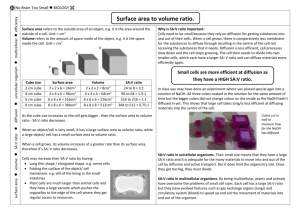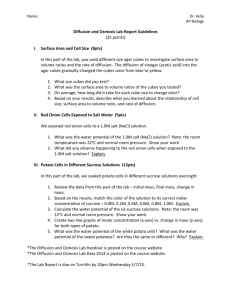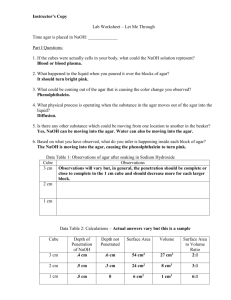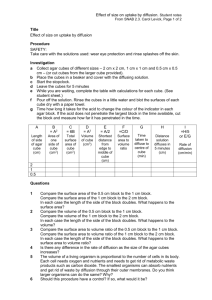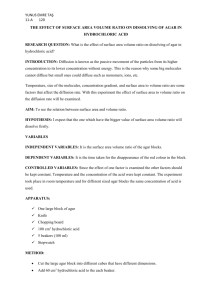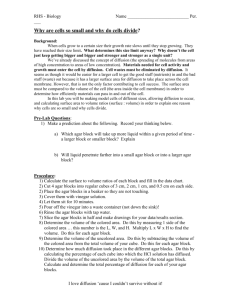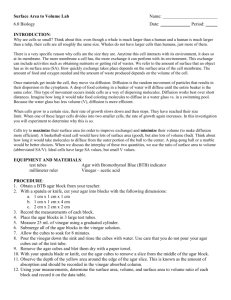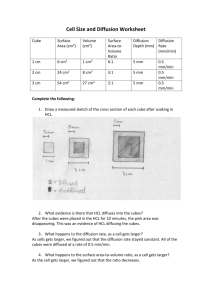Lesson
advertisement
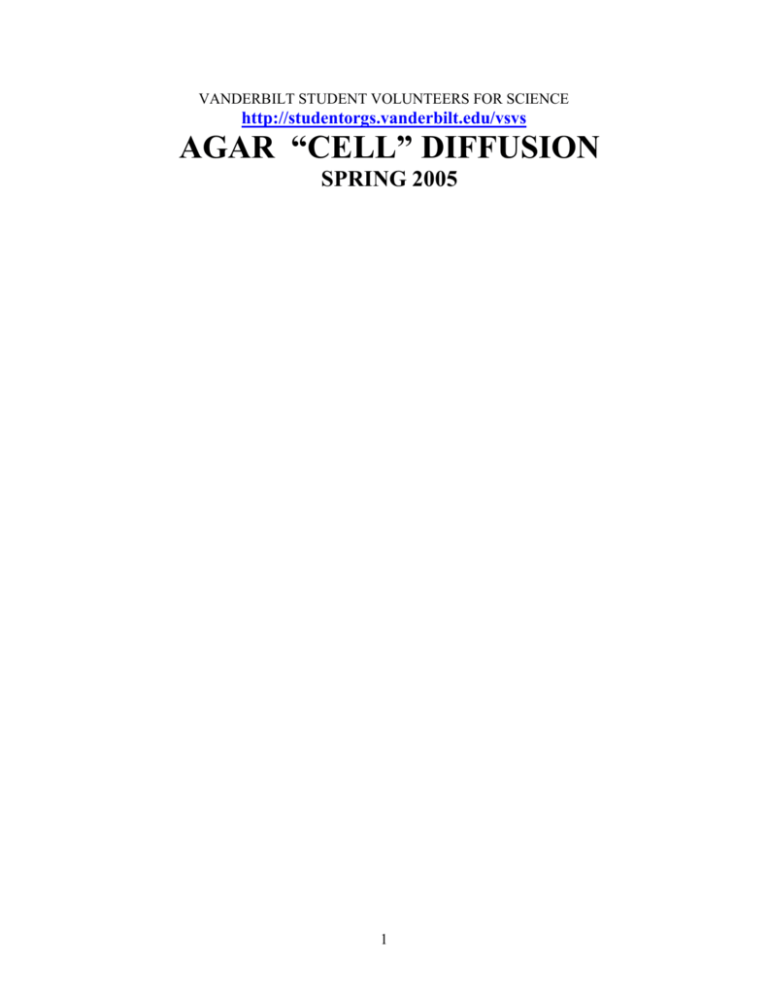
VANDERBILT STUDENT VOLUNTEERS FOR SCIENCE http://studentorgs.vanderbilt.edu/vsvs AGAR “CELL” DIFFUSION SPRING 2005 1 I. INTRODUCTION Ask students: What is a cell? Accept responses. Cells are the structural and functional unit of all living organisms. Some organisms, such as bacteria, are unicellular, consisting of a single cell. Other organisms, such as humans, are multicellular, or have many cells—an estimated 100,000,000,000,000 (one trillion) cells! Each cell is an amazing world unto itself: it can take in nutrients, convert these nutrients into energy, carry out specialized functions, and reproduce as necessary. Even more amazing is that each cell stores its own set of instructions for carrying out each of these activities. Ask students: How do cells grow? Accept responses. Most cells grow, but upon reaching a certain size, a cell will divide becoming two smaller cells. This is how multicellular organisms, like us, grow. Ask students: How do cells take in nutrients and get rid of wastes? Accept responses. Diffusion is the spontaneous movement of a substance from high to low concentration. It is how many substances naturally move from where there is more to where there is less: such as the smell of perfume moving across the room. Diffusion is one of the very important processes by which substances such as nutrients, water, oxygen, and cellular wastes are transported between living cells and their environment. The cell membrane is the selectively permeable barrier whose total surface area is an important factor in regulating the substances that diffuse into or out of the cell. In fact, cells that specialize in absorption or secretion often have relatively large surface areas to increase the efficiency of diffusion (e.g. intestinal cells contain villi and microvilli). Ask students: If a large surface area is helpful, why do cells not grow to be very large? Accept responses. Scientific evidence suggests that once a cell grows to a certain size it becomes too large for the complete diffusion of needed substances throughout its cytoplasm. As a cell grows, its volume increases faster than its surface area; as a result, the surface area of the cell membrane gradually becomes less efficient for the diffusion of substances throughout the entire volume of the cell. The relationship between the surface area and volume of a cell can be expressed as a ratio, and this ratio is believed to be a significant factor in triggering a cell to divide, preventing cells from becoming too large, and maintaining efficient diffusion throughout the cell. I. PREPARATION FOR “CELL” DIFFUSION Safety! Tell students that they will be working with the chemicals sodium hydroxide and phenolphthalein. Although the concentrations are not high, they should still exercise caution. Organize students into groups of three. 2 MATERIALS 10 sets (1 cube and 1 rectangular prism) of plastic cm3 cubes per group 32 observation worksheets 10 aluminum pie pans 1 plastic bag containing: 1 dropper bottle phenolphthalein 1 pipette 1 clear 6oz cup 1 small bottle of 0.05 M NaOH 10 funnels 10 spoons 20 larger clear plastic cups (9oz) 10 smaller clear plastic cups (4oz) 10 styrofoam cups (12oz) with ice 21 containers of 100 mL of 0.05M NaOH 10 containers of 100 mL chilled 0.05M NaOH (keep on ice) 10 agar cubes (2x2x2) at room temperature 10 agar rectangular prism (2x1x4) “cells” at room temperature 10 agar cubes (2x2x2) at refrigerator temperature (or kept on ice) 10 plastic knives 30 rulers – students provide their own (must have a cm/mm side) 1 spatula 1 roll of paper towel Distribute the following materials to each group of 3 students: 1 set (1 cube and 1 rectangular prism) of plastic cm3 cubes 1 aluminum pie pan 2 larger clear plastic cup (9oz) 1 smaller clear plastic cup (4oz) 1 styrofoam cup (12oz) with ice 2 containers of 100 mL of 0.1M NaOH 1 container of 100 mL chilled 0.1M NaOH (keep on ice) 1 agar cube (2x2x2) at room temperature 1 agar rectangular prism (2x1x4) “cell” at room temperature 1 agar cube (2x2x2) at refrigerator temperature (or kept on ice) 1 plastic knife 1 funnel 1 spoon 3 paper towels Distribute to each student: 1 observation worksheet 1 ruler – students provide their own (must have a cm/mm side) 3 Part 1: Understanding the chemical reaction that will be taking place (demonstration): 1. Pipette a small amount of the NaOH the 100ml container of 0.5M NaOH into the cup and note the color (clear). 2. Add a few drops of phenolphthalein and note the color change. 3. Explain to the students that phenolphthalein is an acid/base indicator and will turn pink in the presence of a base (the NaOH). 4. Tell the students that the agar cubes are made with phenolphthalein added, and its surface will immediately turn pink when put into a NaOH solution. The NaOH will continue to diffuse through the cube and gradually turn the inside of the cube pink. The rate the inside of the cube changes color depends on the temperature and size (specifically the surface-to-volume ratio). Part 2: Diffusion with Agar “cells” Remind students that the agar cells contain phenolphthalein. They are not made of gelatin; therefore they are NOT to be eaten. Have students place the smaller 4oz cup in the Styrofoam ice cup. Have students place all the cups in the aluminum pie pan. Have students measure and record the dimensions of the “cells”. (They can calculate the surface-to-volume ratio while the NaOH is diffusing into the “cells”.) Have students place a cubic agar “cell” and the flat agar “cell” into the clear 9oz cups. Have students place the other cubic agar “cell” in the smaller 4oz cup on ice. Instruct the students to carefully pour all of the room temperature NaOH into the 9oz plastic cups and all of the chilled NaOH into the 4oz cup on ice. DO THIS AT THE SAME TIME. Begin timing. The experiment should last approximately 15 minutes, although a few minutes over should not be a problem. Tell them to write down their observations on the back of the observation worksheet. After 15 minutes, have the students carefully pour the NaOH back into the original container and remove the agar cubes from the cup, using the spoon. Tell them to place the cubes on the paper towel and to carefully blot dry the cubes (the cubes will disintegrate if patted too hard). With the plastic knife, have the students cut each “cell” in half. Tell them to draw an accurate cross-section of their observations on their observation worksheet. The drawing should include measurements (in mm) of the areas that have turned pink and those that have not. This must be done immediately since the diffusion will keep occurring after the “cell” has been removed from the solution. Ask students: Which cell experienced the most diffusion? o The flatter “cell” should show more interior pink color than the cube. o The cold NaOH solution and cube causes the rate of diffusion to be slower. 4 EXPLANATION: Diffusion is a fairly slow process and a cell that relies primarily on diffusion to transport essential molecules into and throughout its interior—and to carry wasted products out—could conceivably grow too large for this process to work efficiently. Part 3: Using cm cubes to illustrate surface-to-volume ratio As noted above, the relationship between the surface area and volume of a cell can be expressed as a ratio, and this ratio is believed to be a significant factor in triggering a cell to divide, preventing cells from becoming too large, and maintaining efficient diffusion throughout the cell. Write the table below on the board and fill in the numbers as they are calculated. Give each group a cubic and rectangular shaped set of blocks. Tell the students to draw the “cells” and label the length of each side. Have the students count the blocks in each “cell” (they will be the same – 8) Ask the students to compare the VOLUMES of each “cell”. They can do this by calculating the volume, or noting that the number of cubes in each “cell” is the same. Now ask the students to compare the SURFACE AREAS. They can do this by calculating the areas of the shapes, or by counting the number of cm2 faces. Tell the students that the key to efficient cell diffusion is not the total surface area, but the surface-to-volume ratio. Have the students calculate the surface area-to-volume ratios for both blocks, and have them predict which kind of cell shape would be more efficient. SURFACE AREA AND VOLUME OF DIFFERENT SHAPED “CELL” BLOCKS CELL SIZE Cubic cell (2x2x2) Rectangular cell (2x4x1) SURFACE AREA (cm2) VOLUME (cm3) 2cm x 2cm x 6 =24cm2 OR, number of cm2 faces = 4 x 6 = 24 2cm x 2cm x 2cm = 8 cm3 OR, number of cubes used =8 2cm x 1cm x 2 + 4cm x 1cm x 2 + 4cm x 2cm x 2 = 28 cm2 OR, number of cm2 faces = 28 2cm x 4cm x 1cm = 8cm3 OR, number of cubes used =8 5 SURFACE AREA VOLUME RATIO 3 (24/8) 3.5 (28/8) Teacher Prep 1. Make enough copies of the observation sheet for your students. 2. One set of 10 0.05M NaOH bottles needs to be kept cold – on ice or in the refrigerator until ready to use. 3. There is 1 tray of 2cm deep agar and 1 tray of 1cm deep agar. This lesson is set up for the cells to be cut 2x2x2 and 1x2x4. Agar cells need to be cut very carefully (teacher should do this). Before you start cutting the cells, divide the tray of agar into the number of classes you have so you will know how much agar you have for each class. The number of agar cells, 2x2x2 and 1x2x4, listed in the lesson is based on a maximum of 10 groups. If you have find you don’t have enough agar to do 10 groups, reduce the number of groups per class accordingly. 4. Be sure to save some of the clear NaOH for your demonstration in Part 1. The recycled NaOH is re-used in each class, so students must pour NaOH back into containers. A small bottle (1 L) of extra NaOH is provided in case of spills etc. It doesn’t matter if the recycled NaOH used for the agar cubes is pink since it turns pink as soon as agar cubes are added. 6 INSTRUCTION SHEET – AGAR ‘CELL’ DIFFUSION Safety! You will be working with the chemicals sodium hydroxide and phenolphthalein. Although the concentrations are not high, you should still be very careful. 1. Place the smaller 4oz cup in the Styrofoam ice cup. 2. Place all the cups in the aluminum pie pan. 3. Measure and record the dimensions of the “cells”. 4. Place a cubic agar “cell” and the flat agar “cell” into the clear 9oz cups. 5. Place the other cubic agar “cell” in the smaller 4oz cup on ice. 6. Carefully pour all of the room temperature NaOH into the 9oz plastic cups and all of the chilled NaOH into the 4oz cup on ice. DO THIS AT THE SAME TIME. Begin timing. The experiment should last approximately 15 minutes, although a few minutes over should not be a problem. Write down your observations on the back of the observation worksheet. After 15 minutes, carefully pour the NaOH back into the original container and remove the agar cubes from the cup, using the spoon. Place the cubes on the paper towel and carefully blot the cubes dry (the cubes will disintegrate if patted too hard). 7. With the plastic knife, cut each “cell” in half. Draw an accurate cross-section of your observations on your observation worksheet. The drawing should include measurements (in mm) of the areas that have turned pink and those that have not. Do your drawing quickly since the diffusion will keep occurring after the “cell” has been removed from the solution. Part 3: Using cm cubes to illustrate surface-to-volume ratio As noted above, the relationship between the surface area and volume of a cell can be expressed as a ratio, and this ratio is believed to be a significant factor in triggering a cell to divide, preventing cells from becoming too large, and maintaining efficient diffusion throughout the cell. Fill in the numbers as they are calculated. Look at the cubic and rectangular shaped set of blocks. Draw the “cells” and label the length of each side. Count the blocks in each “cell” Compare the VOLUMES of each “cell”. (Calculate the volume, or count the number of cubes in each “cell”.) Compare the SURFACE AREAS. (Calculate the areas of the shapes, or count the number of cm2 faces.) The key to efficient cell diffusion is not the total surface area, but the surface-tovolume ratio. Calculate the surface area-to-volume ratios for both blocks, and predict which kind of cell shape would be more efficient. 7 OBSERVATION SHEET DATA TABLE 1: AGAR “CELLS” 1. Cube–shaped cell: Draw your “cubic” cell here, and label the lengths of all sides. Surface area of: side 1 = _____ side 2 = _____ side 3 = _____ side 4 = _____ side 5 = _____ side 6 = _____ Total surface area of cube-shaped “cell”: ______________________________________ Volume of cube-shaped “cell”:______________________________________________ Surface-to-volume ratio of cube-shaped “cell”: _________________________________ 2. Flatter cell: Draw your flatter “cell” here and label the lengths of all sides. Surface area of: side 1 = _____ side 2 = _____ side 3 = _____ side 4 = _____ side 5 = _____side 6 = _____ Total surface area of flat “cell”: ______________________________________ Volume of flat “cell”:______________________________________________ Surface-to-volume ratio of flat “cell”: ________________________________ 8 Draw an accurate cross-section of the three “cells”. The drawing should include measurements (in mm) of the areas that have turned pink and those that have not. This must be done immediately since the diffusion will keep occurring after the “cell” has been removed from the solution. “Cell” 1: (Cubic, at room temperature). “Cell” 2: (Flat, at room temperature). “Cell” 3: (Cubic, at ice temperature). 9 DATA TABLE 1: CALCULATING THE SURFACE AREA/VOLUME RATIO CELL SIZE SURFACE VOLUME SURFACE AREA (cm2) (cm3) AREA/VOLUME “Cube” shaped cell (2x2x2) “Rectangular” cell (2x1x4) DATA TABLE 2: RATE OF DIFFUSION CUBE SIZE DEPTH OF TIME (min.) DIFFUSION (cm) cubic (room 15 min temperature) flat (room temperature) 15 min cubic (cold) 15 min RATE OF DIFFUSION (cm/min.) DATA TABLE 3: EXTENT OF DIFFUSION TOTAL VOLUME OF VOLUME OF CUBE CELL (cm3) WHICH HAS NOT CHANGED COLOR cm3 (room temperature, cubic ) cm3 (room temperature, rectangular) cm3 (ice temperature, cubic) 10 PERCENT VOLUME OF CUBE WHICH HAS COLOR CHANGE (extent of diffusion)

